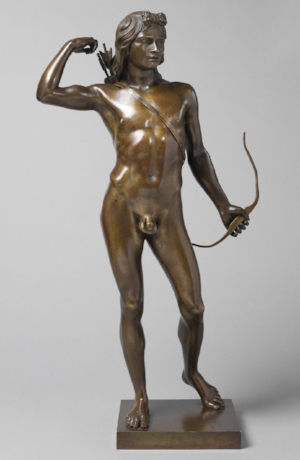Hermeneutics – The Choosing of the Arrow
November 29, 2018
by Angela M. Mosley, Cohort ’16

Henry Kirke Brown’s artwork, commissioned in 1848 by the American Art-Union, was completed in 1849 and is recognized as the first bronze sculpture made in America. The nameplate spoke to Brown’s studies in Italy and his desire to create distinctively American sculptures with unique national themes for distribution to a broad middle-class audience. He complained of the early American sculptors who allowed their artwork to be dominated by Italian influence. But, even though this commissioned piece permitted Brown to travel Michigan’s Mackinac Island in Lake Huron to study the Ottawa and Ojibwe people, he remained faithful to his heavily classical academic instructions from Europe, giving homage to the Greeks and Italians.
For this reason alone I find The Choosing of the Arrow to be problematic. It illustrates the Indian form and character, yet it is depicted from a very Eurocentric perspective. Unless the viewer is knowledgeable of the Native American culture, particularly indigenous to the Midwest region, one could speculate the artwork to be the artist’s interpretation of a living or deceased character in the persona of a mythical figure. While Brown chose to depict this nude Indian youth as a young Apollo preparing for the hunt, there is no recognition of “American” style or technique represented to differentiate this sculpture as a national theme.
One primary critical question is: whose America I am seeing when looking at this piece? I strongly believe the verbiage of the commissioned piece represents a particular story, while the actual visual does not properly reflect the indigenous culture. A viewer not aware of the purpose and necessity of this space and unfamiliar with specific civilizations within North America would blindly perceive this sculpture for face value. It could be seen as just another replica of past art representing classical style with its physical details giving tribute to the Greeks and Italians. Yet, when delving into the spirituality and belief systems of the Native Americans, some tribes were adamant against the imagery reproduction of their being in the human form because it reflected the stealing of the spirit. For an individual to be presented before this sculpture for the first time would require the viewer to be educationally-trained in the philosophical beliefs and customs of Native Americans, from tribal markings to particular fashion customs in accordance with each respective tribe. My first impression of it was that the artist depicted a European figure, and it is being exhibited in space marked for the “Other.” I feel as if this artwork was a significant contribution to the complete whitewashing of the story and people of the Native American tribes. It angered me because it is a mirrored image to my ancestral story.
I questioned and am still questioning assimilation and individualized integration of culture. How much is too much assimilation, and how much is too little integration? While Brown’s aim of The Choosing of the Arrow was to illustrate the form and character of America’s indigenous population, he revealed the model from a very Eurocentric perspective, except for the hair knot which was indicative of a particular indigenous tribe in the Midwest region. The researched histories and shared fragmented stories of living ancestors who have breathed an attempt of a cultural annihilation echoed in my head, “his story is your story…your story is America’s forbidden and untold story.” I needed to remove myself from the space because I am still yet unable to rationalize the voices of the constructed power.
